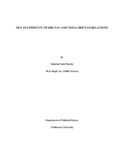Please use this identifier to cite or link to this item:
http://archive.nnl.gov.np:8080/handle/123456789/141| Title: | Multi-ethnicity of Bhutan and Nepal-Bhutan relations |
| Authors: | Pandey, Nishchal Nath |
| Keywords: | Ethnicity--Bhutan Nepal-Bhutan relation |
| Issue Date: | 1-Jun-2018 |
| Abstract: | Nepal and Bhutan, although close geographically, religiously and culturally have had a difficult relationship mainly due to the issue of Bhutanese refugees which erupted since 1991. Failure to repatriate the 1,04,000 Lhotsampas to their rightful motherland has much to do with the unsympathetic attitude borne out of insecurity of the Druk regime, political instability, lack of a clear strategy and mishandling by Nepal and India's indifference to the suffering of the refugees. The democratic movement initiated by the ethnic Nepalese in Southern Bhutan was not successful in the early 90s but Bhutan has been going through gradual political transformation with the first ever elections in which at least two political parties were allowed to participate held in 2008. However, the majority of the Lhotsampas have called these elections a sham whereas the situation has also been marked by some degree of violence spearheaded by CPB (Maoists). Without the democratic mainstream, the extreme polarity is likely to get further sharpened in due course of time which will not be in the interest of either the Wangchuk dynasty or New Delhi which enjoys special relations with Bhutan. Indo-Bhutan relations is the only bilateral relations in its neighbourhood that New Delhi can boast of having been steady, warm and hassle-free. But this has also to do with the uninterrupted export of hydro-electricity to the power hungry states of India and Bhutan's refusal to establish diplomatic relations with China and the U.S. The Lhotsampas were brought to Bhutan initially for building monasteries, tea plantation and construction of roads with the approval of the various incumbent monarchs. Most of them started to settle in Bhutan. Simply to say that they are foreigners, forcibly confiscating their property and compelling them leave the country is an abuse of human rights. The U.S. resettlement program has certainly helped ease tensions between Nepal and Bhutan but we need to comprehend that this is not a permanent solution. There is also the concern of Lhotsampas that are still living in southern Bhutan; their predicament and future remains an area of grave anxiety in the context of violent movements in other areas of India's Northeast involving Nepali speakers. Nepal and Bhutan have no other bilateral issues to settle other than the refugee problem. The bilateral relations were formally established in 1983. While King Jigme and Late King Birendra both have visited each other's country under the aegis of SAARC, there has been no head of state-level visit after 2006. From the Bhutan side, the Queen Mother and the Prime Minister visited Nepal in 2011. The two countries are close culturally, through the Buddhist religious affinity and in the modern day through daily fights and commercial inter-changes. There is a dire need to erect a durable foundation for cementing of the relations in all spheres. Alongside, a strong focus on trade, investment and tourism between the two countries will create a backbone for the relations. Through the aegis of SAARC, UN, BIMST-EC and other international and regional frameworks, Nepal and Bhutan are already working towards enhancing their relations which needs to be nurtured at all levels. |
| Description: | Department of political Science, Tribhuvan University, 2064 |
| URI: | http://103.69.125.248:8080/xmlui/handle/123456789/141 |
| Appears in Collections: | 300 Social sciences |
Files in This Item:
| File | Description | Size | Format | |
|---|---|---|---|---|
| 79-Dr. Nishchal Nath pandey.pdf | 1.08 MB | Adobe PDF |  View/Open |
Items in DSpace are protected by copyright, with all rights reserved, unless otherwise indicated.